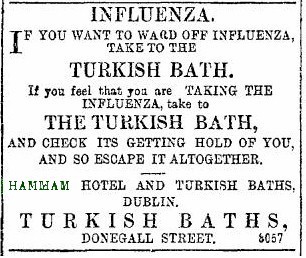Advertisement advocating Turkish baths to ward off influenza

The practice, initiated by William Potter and developed by Charles Bartholomew, of advertising the Victorian Turkish bath as a cure for all manner of diseases, continued right into the middle of the 20th century.
Yet some of the claims made were not completely outrageous at a time when blood-letting was still a major treatment for almost anything, and when there were very few diseases which the doctors themselves were able to cure.
This advertisement is of particular interest because between the years 1889 and 1919, a succession of influenza epidemics in Britain caused concern in the medical profession, and panic in some sections of the community. Doctors were unable to identify the cause of the infection, or discover how it spread. So many patients, given that the early symptoms seemed to be the same as those for a cold, chose to use over-the-counter products for treatment and relief. The use of such remedies was, as was to be expected, roundly condemned by doctors as quackery.
Yet an article written in 20051 analysed articles published at the time in the British Medical Journal and The Lancet. The author found that there was 'not only confusion and lack of consensus, but also a range of treatments which were remarkably similar to the very commercial remedies doctors denounced'. And she concluded that 'commercial panaceas for influenza, such as Turkish baths, carbolic vaporizers, medicated wines, and anti-bacterial lozenges, provided relief that was in accordance with best professional advice'.
This page adds an image to illustrate an advertisement
advocating Turkish baths to ward off influenza,
mentioned on page 89 of my book
Victorian Turkish Baths

VICTORIAN TURKISH BATHS
by Malcolm Shifrin
Published
2015
by Historic England
in partnership with Liverpool University Press
Distributed in the US by Oxford University Press
ISBN: 978-1-84802-230-0
Comments and queries are most welcome and can be sent to:
malcolm@victorianturkishbath.org
The right of Malcolm Shifrin to be identified as the author of this work
has been asserted by him
in accordance with the
Copyright, Designs and Patents Act 1988
© Malcolm Shifrin, 2015-2023